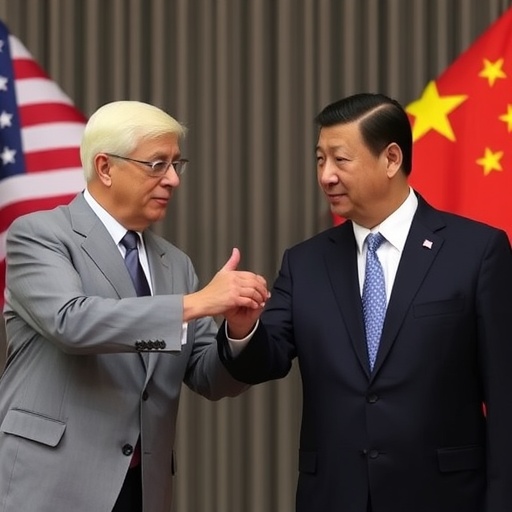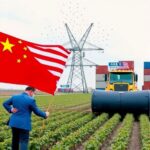US-China Framework Agreement Averts Tariff Escalation: Boost for Soybeans and Rare Earth Supply Chains
In a pivotal move to de-escalate simmering trade tensions, Treasury Secretary Scott Bessent announced on Wednesday a groundbreaking framework agreement between the United States and China. This deal aims to prevent a fresh wave of tariffs and delay China’s planned export controls on rare earth minerals, offering immediate relief to American industries and farmers alike. The agreement, forged after months of behind-the-scenes negotiations, signals a potential thaw in US-China relations and could pave the way for broader economic cooperation.
The announcement comes at a critical juncture, as both nations grapple with the fallout from previous trade disputes. Under the framework, the U.S. has agreed to hold off on imposing additional tariffs on Chinese goods, while Beijing commits to postponing restrictions on rare earth exports—vital materials used in everything from electric vehicles to defense technologies. Furthermore, China has signaled its intent to resume large-scale purchases of U.S. soybeans, a lifeline for Midwestern farmers battered by years of export uncertainties.
This development is particularly timely, with global supply chains still reeling from pandemic disruptions and geopolitical frictions. Economists estimate that without this agreement, new tariffs could have added billions to U.S. consumer costs and further strained bilateral trade, which topped $690 billion in 2023 according to U.S. Census Bureau data.
Treasury Secretary Bessent Highlights Framework’s Core Pillars
Treasury Secretary Scott Bessent, speaking at a press conference in Washington D.C., described the framework as a “substantial step toward stabilizing US-China relations.” He emphasized that the agreement addresses immediate pain points while laying the groundwork for deeper talks. “We’ve crafted a balanced approach that protects American interests without closing the door on collaboration,” Bessent stated, underscoring the deal’s focus on reciprocity and mutual benefits.
Key elements of the framework include a 90-day moratorium on tariff hikes, during which both sides will engage in technical discussions on intellectual property and market access. Bessent revealed that the U.S. delegation, which included representatives from the Office of the U.S. Trade Representative, worked tirelessly to secure concessions on rare earth minerals. These elements, comprising over 80% of the world’s supply from China, have been a flashpoint in tech rivalries.
Statistics from the U.S. Geological Survey highlight the urgency: China controls 63% of global rare earth mining and 85% of processing capacity. Export controls announced earlier this year threatened to disrupt U.S. manufacturing, potentially increasing costs for semiconductors by up to 20%, according to industry analysts at the Semiconductor Industry Association.
Bessent also touched on the agricultural front, noting that the soybean provision could inject $5 billion into the U.S. economy annually. “This isn’t just about trade numbers; it’s about supporting families in rural America who have borne the brunt of past tariffs,” he added, referencing how U.S. soybean exports to China plummeted from 31 million metric tons in 2017 to under 15 million in 2018 due to retaliatory measures.
Rare Earth Minerals Deal Eases Pressure on U.S. Tech Sector
The delay in Chinese export controls on rare earth minerals stands out as one of the framework’s most significant wins for the U.S. technology and defense industries. Rare earth elements like neodymium and dysprosium are indispensable for producing high-strength magnets in wind turbines, electric motors, and military hardware. With China dominating the market, any restrictions could have crippled supply chains, leading to shortages and price spikes.
Under the agreement, China has pledged to maintain current export levels for at least six months, allowing U.S. firms time to diversify sources. This comes after Beijing’s February announcement of tighter controls, which sent rare earth prices surging 15% in global markets within weeks, per data from Argus Media.
Industry leaders have welcomed the news. “This framework provides the breathing room we need to build resilient supply chains,” said Lisa Porter, CEO of a major U.S. battery manufacturer, in a statement to Reuters. She highlighted how reliance on Chinese rare earths has exposed American companies to geopolitical risks, with the U.S. importing 74% of its needs from China in 2022.
Broader context reveals the strategic importance of this sector in US-China relations. The Biden administration has invested $1.2 billion through the Defense Production Act to boost domestic rare earth production, including a new facility in Texas set to come online next year. However, experts warn that full independence could take a decade, making diplomatic frameworks like this one essential.
Environmental concerns also factor in. Rare earth mining is notoriously polluting, and China’s dominance has raised sustainability issues. The agreement includes provisions for joint research on greener extraction methods, potentially fostering long-term cooperation beyond trade.
Soybean Farmers Eye Renewed Exports Amid Trade Thaw
For American soybean farmers, the framework agreement represents a beacon of hope after years of volatility. China’s commitment to resume purchases could restore a vital market that once accounted for 60% of U.S. soybean exports. The American Soybean Association estimates that full resumption could add 20 million metric tons to annual shipments, stabilizing prices that have hovered around $12 per bushel—down from $14 peaks in 2022.
Farmers in states like Iowa and Illinois, where soybeans are a cornerstone crop, have faced immense pressure from tariffs and alternative suppliers like Brazil. “We’ve lost billions in revenue since the trade war began, and this deal could turn things around,” said John Smith, president of the Iowa Farm Bureau, in an interview with CNBC. He recounted how many operations teetered on bankruptcy in 2019, prompting federal aid packages totaling $28 billion.
The soybeans aspect of the trade agreement ties directly into agricultural diplomacy. During the Trump era, China shifted to South American suppliers, boosting Brazil’s exports by 50%. Now, with U.S. yields reaching record 51.9 bushels per acre in 2023 per USDA data, American producers are poised to recapture market share.
Economists project that renewed Chinese demand could lower global soybean prices by 5-10%, benefiting food manufacturers worldwide. However, challenges remain: U.S. farmers must navigate logistics costs inflated by the Red Sea disruptions and ensure compliance with China’s strict quality standards.
This provision also underscores the human element of US-China relations. Rural communities, hit hardest by trade disruptions, stand to gain from job preservation and investment in processing facilities. The framework encourages bilateral agricultural forums to address issues like pest control and sustainable farming practices.
Global Markets React to Tariff De-Escalation Signals
Financial markets responded positively to the framework announcement, with U.S. stock futures rising 1.2% in after-hours trading and the yuan strengthening against the dollar. The S&P 500’s materials sector, which includes rare earth-dependent firms, saw a 2% uptick, reflecting investor optimism about stabilized supply chains.
Analysts from Goldman Sachs noted that averting new tariffs could add 0.5% to U.S. GDP growth in 2024, based on models factoring in reduced import costs. “This trade agreement reduces uncertainty, which is the biggest drag on investment,” said senior economist Maria Gonzalez in a research note.
On the Chinese side, state media praised the deal as a “win-win” for bilateral ties, with the Shanghai Composite Index gaining 0.8%. However, skeptics caution that implementation will be key, given past instances where agreements faltered over enforcement disputes.
The framework’s ripple effects extend to allies. European automakers, reliant on both U.S. soybeans for biofuels and rare earths for EVs, expressed relief. The EU, which imposed its own tariffs on Chinese EVs last month, may now pursue similar de-escalation paths.
Trade data illustrates the stakes: U.S. exports to China fell 20% year-over-year in Q1 2024 amid tariff fears, per Commerce Department figures. Restoring confidence could reverse this trend, benefiting exporters from apparel to aircraft parts.
Path Forward: Negotiations Gear Up for Lasting Trade Stability
As the initial framework takes shape, both nations are preparing for intensive follow-up talks scheduled to begin in Geneva next month. U.S. negotiators aim to expand the deal into a comprehensive trade agreement covering digital services and climate commitments, building on the Paris Accord’s cooperative spirit.
Challenges loom, including domestic political pressures. With U.S. midterm elections approaching, lawmakers from both parties will scrutinize the deal’s protections for workers and national security. In China, economic slowdowns—GDP growth at 4.7% in Q2—add urgency to securing stable trade partners.
Experts like those at the Peterson Institute for International Economics foresee a multi-phase rollout: Phase one focuses on tariffs and agriculture, phase two on rare earths and tech transfers. Success here could model resolutions for other global disputes, from Ukraine grain exports to Indo-Pacific alliances.
Ultimately, this framework underscores a pragmatic shift in US-China relations—from confrontation to managed competition. By addressing soybeans, rare earth minerals, and tariffs head-on, both powers demonstrate that dialogue can yield tangible benefits, setting the stage for a more predictable economic future. Stakeholders across industries are watching closely, hopeful that this marks the beginning of sustained progress.








